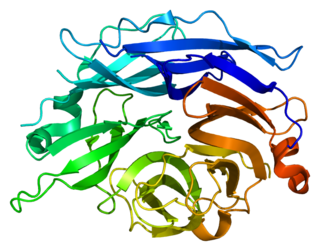
Neuraminidase (Sialidase) enzymes are glycoside hydrolase enzymes that cleave (cut) the glycosidic linkages of neuraminic acids. Neuraminidase enzymes are a large family, found in a range of organisms. The best-known neuraminidase is the viral neuraminidase, a drug target for the prevention of the spread of influenza infection. The viral neuraminidases are frequently used as antigenic determinants found on the surface of the influenza virus. Some variants of the influenza neuraminidase confer more virulence to the virus than others. Other homologues are found in mammalian cells, which have a range of functions. At least four mammalian sialidase homologues have been described in the human genome . Sialidases may act as pathogenic factors in microbial infections.

Neuraminic acid (5-amino-3,5-dideoxy-D-glycero-D-galacto-non-2-ulosonic acid) is an acidic (in particular ulusonic) amino sugar with a backbone formed by nine carbon atoms. Although 9-carbon sugars do not occur naturally, neuraminic acid may be regarded as a theoretical 9-carbon ketose in which the first link of the chain (the –CH2OH at position 1) is oxidised into a carboxyl group (–C(=O)OH), the hydroxyl group at position 3 is deoxidised (oxygen is removed from it), and the hydroxyl group at position 5 is substituted with an amino group (–NH2). Neuraminic acid may also be visualized as the product of an aldol-condensation of pyruvic acid and D-mannosamine (2-amino-2-deoxy-mannose).

Leukotriene C4 synthase is an enzyme that in humans is encoded by the LTC4S gene.
In enzymology, a N-acylneuraminate-9-phosphate synthase (EC 2.5.1.57) is an enzyme that catalyzes the chemical reaction

Bifunctional UDP-N-acetylglucosamine 2-epimerase/N-acetylmannosamine kinase is an enzyme that in humans is encoded by the GNE gene.

Lipoamide acyltransferase component of branched-chain alpha-keto acid dehydrogenase complex, mitochondrial is an enzyme that in humans is encoded by the DBT gene.

Alpha-N-acetylneuraminide alpha-2,8-sialyltransferase is an enzyme that in humans is encoded by the ST8SIA1 gene.

Hyaluronan synthase 1 is an enzyme that in humans is encoded by the HAS1 gene.

2-Oxoisovalerate dehydrogenase subunit beta, mitochondrial is an enzyme that in humans is encoded by the BCKDHB gene.

Hyaluronan synthase 3 is an enzyme that in humans is encoded by the HAS3 gene.

CMP-sialic acid transporter is a protein that in humans is encoded by the SLC35A1 gene.

N-acylneuraminate cytidylyltransferase is an enzyme that in humans is encoded by the CMAS gene.

Beta-1,4 N-acetylgalactosaminyltransferase 1 is an enzyme that in humans is encoded by the B4GALNT1 gene.

ST6 (alpha-N-acetyl-neuraminyl-2,3-beta-galactosyl-1,3)-N-acetylgalactosaminide alpha-2,6-sialyltransferase 4, also known as sialyltransferase 3C (SIAT3-C) or sialyltransferase 7D (SIAT7-D) is a sialyltransferase enzyme that in humans is encoded by the ST6GALNAC4 gene.

Cytidine monophospho-N-acetylneuraminic acid hydroxylase (Cmah) is an enzyme that is encoded by the CMAH gene. In most mammals, the enzyme hydroxylates N-acetylneuraminic acid (Neu5Ac), producing N-glycolylneuraminic acid (Neu5Gc). Neu5Ac and Neu5Gc are mammalian cell surface proteins that are part of the sialic acid family. The CMAH equivalent in humans is a pseudogene (CMAHP); there is no detectable Neu5Gc in normal human tissue. This deficiency has a number of proposed effects on humans, including increased brain growth and improved self-recognition by the human immune system. Incorporation of Neu5Gc from red meat and dairy into human tissues has been linked to chronic disease, including type-2 diabetes and chronic inflammation.

Aflatoxin B1 aldehyde reductase member 2 is an enzyme that in humans is encoded by the AKR7A2 gene.

Alpha-N-acetylgalactosaminide alpha-2,6-sialyltransferase 1 is an enzyme that in humans is encoded by the ST6GALNAC1 gene. This enzyme adds a N-Acetylneuraminic acid to an O-linked N-Acetylgalactosamine (GalNAc) on a peptide/proteins with an α2-6 linkage to produce the sialyl-Tn antigen. It has been shown that the enzyme prefers Thr over Ser containing GalNAc residues.

1-acyl-sn-glycerol-3-phosphate acyltransferase gamma is an enzyme that in humans is encoded by the AGPAT3 gene. The protein encoded by this gene is an acyltransferase that converts lysophosphatidic acid into phosphatidic acid, which is the second step in the de novo phospholipid biosynthetic pathway. The encoded protein may be an integral membrane protein. Two transcript variants encoding the same protein have been found for this gene.

Sodium-dependent phosphate transport protein 1 is a protein that in humans is encoded by the SLC17A1 gene.

Sialidase-2 is an enzyme that in humans is encoded by the NEU2 gene.




















